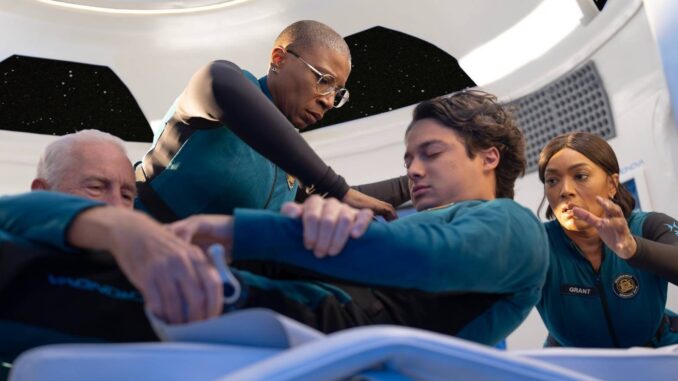
The first episode in 9-1-1’s three-part Season 9 premiere set the stage for the season’s big opening emergency, which sees things going awry when Hen (Aisha Hinds) and Athena (Angela Bassett) go to space. The season’s second episode, “Spiraling,” starts off with some mockumentary-style interviews where Hen, Athena, and the rest of the people on their space shuttle talk about their upcoming trip to space. The trip is supposed to be just a quick orbit, but because this is 9-1-1, things don’t go as planned.
The episode starts with Hen and Athena planning for their trip, and their loved ones getting ready to send them off, and then the show doesn’t waste any time taking them to space. As it turns out, though, there is an almost-fifty percent chance of a geomagnetic storm happening while they’re there. The billionaire who sent them, Tripp Houser (Mark Consuelos), is advised to cancel the trip, but he decides to keep this a secret and send them anyway.
When a series like 9-1-1 promises edge-of-your-seat thrills, you expect heart-pounding rescues, emotional gravity, and characters pushed to their limits. Sadly, Season 9 Episode 2 doesn’t quite deliver. Instead of rising tension, we’re left with stutters, missed beats, and a sense of “been there before.” In this review, we’ll dig into what’s going wrong—and why these high-stakes episodes just aren’t hitting like they used to.
9-1-1 Season 9 Episode 2 Review
Opening Act — The Premise & Promise
From the first scene, the episode tries hard. We’re dropped into a major emergency: multiple cars colliding in a massive crash, potential trapped victims, and split-second decisions. It’s classic 9-1-1 territory. We expect heroism, edge-of-seat tension, and emotional fallout. But as the episode rolls on, the promise begins to fray.
What Doesn’t Quite Work
Overstuffed Plotlines with Shaky Focus
One of the first issues: there’s too much going on. Between the crash, subplots about characters’ personal lives, and hints at looming threats, the episode feels overcrowded. Some threads never land. Too many side-stories steal oxygen from the main drama.
Emotional Beats That Fall Flat
We want to feel the stakes. But when characters face emotional breakthroughs or losses, the reactions feel forced, not earned. We’re told to care more than we’re shown caring. That’s a problem for a show built on emotional impact.
Character Arcs That Circle the Drain
Instead of growth, many arcs feel stuck. Characters we know and love aren’t evolving—they’re just rehashing old conflicts. When your cast doesn’t move forward, the tension evaporates.
Highlights — What Still Works
Big-Scale Rescues & Set-Piece Moments
When the show leans into its core strength—dramatic rescues and high-risk situations—it still delivers. The crash sequence is visually compelling, the effects solid, and the stakes are genuine. These are reminders the show still knows how to thrill.
Supporting Cast That Shines
Even if the main beats flounder, secondary characters steal moments. The paramedics reacting under pressure, side-rescue teams, and small acts of courage add texture. Sometimes the best parts are in the margins.
Why These High-Stakes Episodes Aren’t Hitting Anymore
Genre Fatigue & Predictability
After multiple seasons, surprises become fewer. The formula—disaster, rescue, emotional blowback—is familiar. When your playbook is predictable, the tension loses its punch.
Inconsistent Pacing & Tonal Whiplash
Here you have a dramatic rescue; there you have a sitcom-level banter about relationships. The transitions jar. A show that handles extremes must tie them together cleanly—9-1-1 sometimes stumbles.
Overreliance on Melodrama
Tears, revelations, breakdowns—these were once compelling. Now they feel repetitive, like a drum beaten too often. The more you rely on melodrama, the more it drains emotional returns.
Underestimation of the Audience
Fans are smart. We don’t need clunky exposition or forced conflict. When writing leans on clichés (“Oh, I can’t tell you!”) we roll our eyes. The show needs to trust viewers more.
Episode 2 Scene-by-Scene Breakdown
Act One – The Crash & Initial Chaos
-
Crash sequence: high impact, nicely shot, multiple vehicles, chaos.
-
First responders dispatched: urgency, some confusion.
-
Initial saves & split-second calls: the show peaks there.
Act Two – Personal Conflicts & Distractions
-
Rescue crews deal with family drama.
-
A subplot about a romantic squeeze-in.
-
A character informed of a hidden trouble—but minimal payoff.
Act Three – Climax & Fallout
-
The final trapped victim rescue is tense.
-
Emotional reaction: grief, relief, tears.
-
But the gut punch is muted. It’s a moment that should sting, yet it barely scratches.
Key Characters – Performances & Arcs
The Lead Responders
These characters carry the show. In Ep. 2, their performance is solid, but their arcs feel recycled. There’s glimmers of friction, but few surprises.
Supporting Players & Cameos
We get some scenes that work because the supporting cast is allowed to be themselves. These minor arcs sometimes resonate more than the main ones.
Character Relationships & Tension Points
Romantic tension, past betrayals, family issues—all tested again. But when your relationships reset quickly, the tension dulls.
Writing & Directing — Craft Under the Hood
Dialogue — Earned or Exposition?
Too often, the dialogue feels like it’s delivering key plot info rather than arising naturally. That undercuts authenticity.
Direction & Pacing — When It Drags
Scenes meant to escalate sometimes crawl. The pacing is uneven: moments that should linger feel rushed, while filler drags too long.
Visual Style & Cinematography
The show still looks good. Cinematic disaster sequences, lighting, camera angles—all strong. But style can’t fully compensate when structure wobbles.
Comparing Ep. 2 to Earlier Highs
The Golden Era of 9-1-1
Think back to Season 2 or 3—episodes that stunned and moved. They balanced stakes and heart. Ep. 2 of S9 lacks that balance.
What’s Changed in Nine Seasons?
-
The genre evolved—other shows raise the bar.
-
Audience expectations climbed.
-
Writers may recycle successful tropes too often.
Can the Show Bounce Back?
Yes—if it refocuses. Trim the excess. Give characters real growth. Trust quieter moments. Embrace risk, not formula.
Tips for Making High-Stakes Episodes Hit Again
Tighten Storylines, Kill the Fluff
Focus on 1–2 arcs per episode. Too many threads dilute drama.
Let Emotional Arcs Breathe
Don’t rush breakthroughs. Show the journey, not just the end.
Reinvent Conflict
Don’t always fall back on the same triggers. New dilemmas, unexpected alliances, moral quandaries.
Use Subtlety Over Shocks
Less is sometimes more. A quiet reveal can land harder than an overblown confession.
Audience Reception & Expectations
Fan Reactions on Social Media
Many fans express frustration: “I love 9-1-1, but lately it feels safe.” That echoes this episode’s problems.

Tension Between Legacy & Innovation
Long-running shows struggle: How much to stay the same? How much to evolve? The balance is delicate.
Surviving Critical Scrutiny
Critics demand more from established series. Mediocre rescue chaos isn’t enough. Themes, subtext, character stakes matter more than ever.
Conclusion
9-1-1 Season 9 Episode 2 attempts to deliver a high-octane drama full of rescues, split-second decisions, and emotional reckonings. Yet despite the spectacle, something feels missing. The episode is overstuffed, its emotional beats undercooked, its character arcs stagnating. The show can still nail a thrilling rescue or minor performance moment—but the glue that binds it all together is slipping.
To regain its footing, 9-1-1 needs to simplify, refocus, and trust its audience. Drops in tension and originality won’t kill the show—but they’ll erode its soul. And for a drama built on heroism, heart, and danger, the soul is everything.
FAQs
1. Why does Season 9 Episode 2 feel less impactful than earlier seasons?
Because it leans too heavily on familiar tropes, overloads its plotlines, and fails to deepen its emotional stakes. The formula is less surprising now, and the writing doesn’t always push new boundaries.
2. Are the rescue scenes still well done?
Yes—they remain a highlight. The visual execution and tension in the actual rescue sequences are among the stronger elements of the episode.
3. Do any characters undergo meaningful growth in this episode?
Not particularly. The arcs mostly rehash old conflicts or hint at change without fully delivering. That lack of progression weakens the dramatic weight.
4. Could subsequent episodes recover from this misstep?
Absolutely. If the show trims excess, focuses on fewer arcs, and elevates emotional authenticity, it can recapture momentum.
5. What’s one thing the writers should stop doing to improve?
Stop overloading episodes with too many threads. Focus on fewer storylines and let real character-driven conflict carry the weight.
